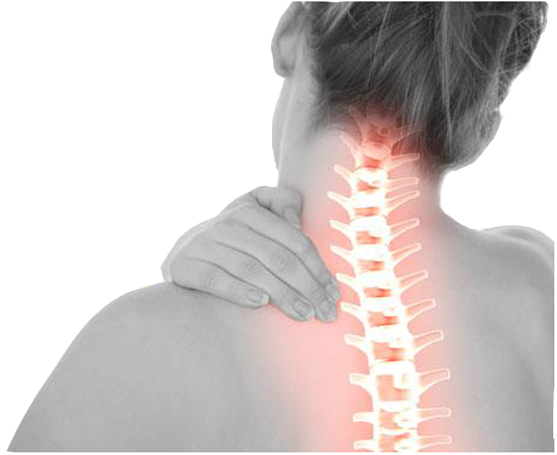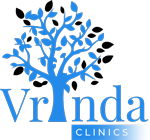Cervical & Lumbar Disc
INTRODUCTION
Shooting pain to the shoulders and arms with local neck pain, tingling and numbness, with loss of fine motor skills in the fingers needs to be treated for Cervical Disc Prolapse.

1What are the symptoms of cervical spondylosis?
Symptoms can vary from mild to severe. You may have a flare-up of symptoms if you over-use your neck, or if you sprain a neck muscle or ligament. Symptoms include:
• Pain in the neck. This may spread to the base of the skull and shoulders. Movement of the neck may make the pain worse. The pain sometimes spreads down an arm to a hand or fingers. This is caused by irritation of a nerve that goes to the arm from the spinal cord in the neck. The pain tends to wax and wane with flare-ups from time to time. However, some people develop chronic (persistent) pain.
• Some neck stiffness, particularly after a night's rest.
• Headaches from time to time. The headaches often start at the back of the head just above the neck and travel over the top to the forehead.
• Numbness, pins and needles or weakness may occur in the part of the arm or hand. Tell a doctor if these symptoms occur as they may indicate a problem with a 'trapped nerve'.
2What are these caused due to?
• Pain in the neck region can be caused by a variety of reasons. Different centers in and around the cervical vertebrae are sensitive to pain and problems connected with any of these regions can cause pain. The Periosteum ( The outer layer of the cervical vertebrae), The anterior and posterior ligaments ( the ligaments which run along the vertebrae and stabilize them ), The facet joints ( the joint formed between the sideward protrusions of the vertebrae ) The para-vertebral muscles are all pain-sensitive and any lesions to the above structures are capable of producing pain.
• Pain, numbness and lack of sensation in the other areas are produced by problems affecting the nerves that emerge from the cervical region. By far, the most common cause of cervical spondylosis is the spasm of the paravertebral muscles of the neck.
• The main causes of these problems are 1) Spondylosis, 2) Herniated inter-vertebral disks, 3) Fibro-myalgia, and myofascial pain syndromes. Though the three refer to three different entities, they are interrelated and often super-imposed.
With age, osteophytes, or bone spurs form on vertebral bodies, as the body’s way of attempting an increase of the surface area and stabilizing the vertebral joint. Generally not successful in this mission, the bone spurs can become painful as they put pressure on cervical nerves, and in some cases the spinal cord. And may also result in shoulder pain.
Symptoms
Cervical spondylosis can lead to chronic pain and stiffness in the neck that may also lead to numbness of the upper extremities.
- Well the most common symptoms with which these patients approach the doctor are
- Pain and stiffness in the neck.
- The pain and stiffness could be confined to the neck alone
- There could be radiation of the pain from the neck to the right hand
- There could be radiation of the pain from the neck to the left hand
- There could be radiation of the pain from the neck to the back of the head
- There could be giddiness associated with pain and stiffness
- There could be only pain in the upper arm
- There could be numbness in the tips of the fingers
- These above symptoms could all suggest that you could be suffering from a condition known as cervical spondylosis
- Neck stiffness and pain may be worse with upright activities.
- Numbness and weakness may appear in the arms, hands, and fingers, and weakness in the legs.
- May feel or hear grinding or popping in the neck when you move.
- Muscle spasms or headaches.
- May feel irritable and fatigue, disturb sleep and impair your ability to work.
The diagnosis is usually through physical examination and imaging.
- Physical exam - the doctor may identify tender spots along the neck and evaluate your ability to move the neck in various directions. The function of the nerves and muscles in the arms and legs may be tested.
- Imaging - X-rays and MRI studies may be used to show bone spur and other abnormalities and reveal the extent of damage to the cervical
Treatment for cervical spondylosis -TYPE A
----------------->>
Exercise your neck and keep active and aim to keep your neck moving as normally as possible. As far as possible, continue with normal activities. In the past, some people have worn a neck collar for long periods when a flare-up of neck pain developed. It is now known that if you wear a collar for long periods it may cause the neck to 'stiffen up'. So, try to keep it as active as possible.
EXERCISES FOR SPONDYLOSIS
----------------->>
Professionals who spend hours doing desk work or in front off the computers should take small breaks in between and try and do simple neck exercises Some of those neck pains and stiffness which does not improve in spite of exercise and medication are most certainly due to stress. When a person is in constant stress the muscles in the neck goes into spasm and causes pain and stiffness in the neck so it is very important for the doctor to identify the cause and treat it accordingly.
Visit Today
You'll know the minute you arrive this is the place. We are here to surpass your desires.
Treatment for cervical spondylosis- Homeopathy-TYPE B
----------------->>
The symptoms may last for several months or years. Most of the time if symptoms are mild, the doctor may recommend rest, medication, and physical therapy.
- Rest - may need to wear a soft cervical collar or neck brace to limit neck motion to relieve nerve irritation.
- Medication -medications or other non-narcotic pain relievers to relieve pain and reduce swelling.
- Physical therapy - Hot and cold cervical traction or active exercise program to relieve pain symptoms.
